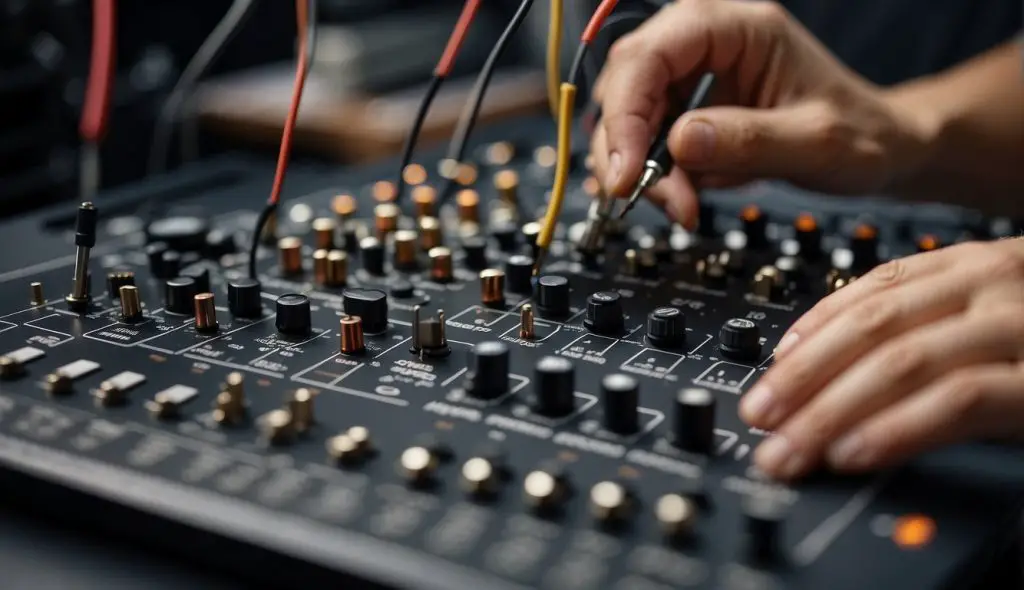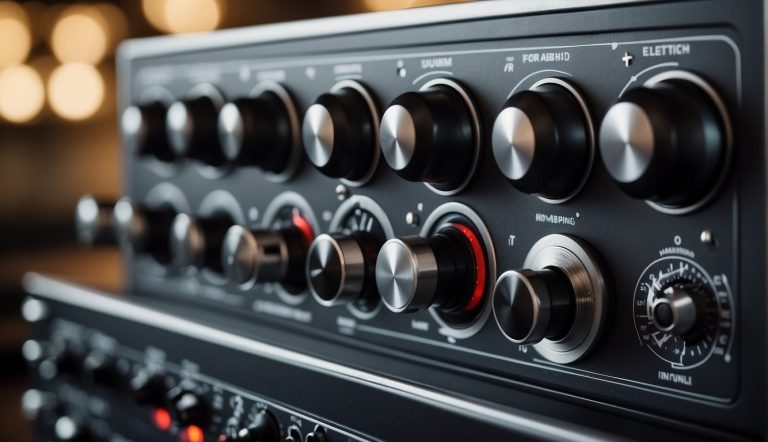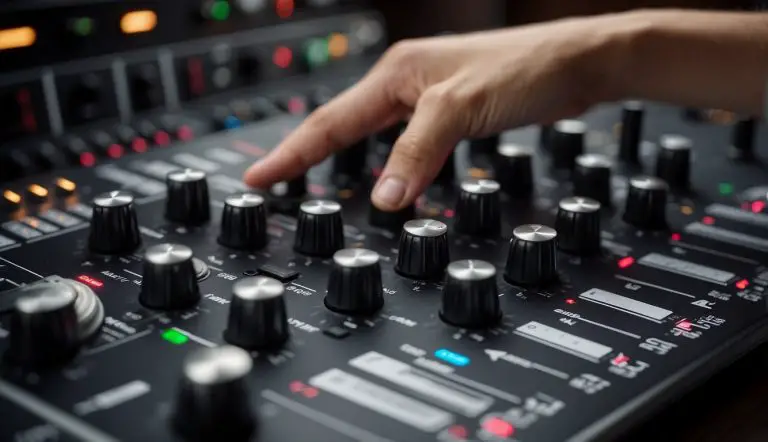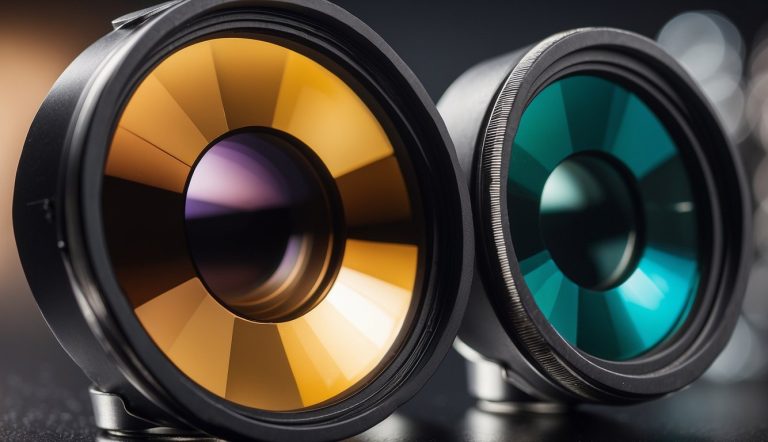Audio Pass Filter Guide: Understanding and Using Filters in Sound Engineering
In the world of music production, audio pass filters are essential tools for sculpting and managing the frequency content of an audio signal.
Essentially, these filters allow certain frequencies to ‘pass through’ while attenuating others, hence the name.
There are several types of pass filters, each designed for a specific purpose within the audio processing chain.
Low-pass filters, for example, are used to eliminate high-frequency noise, whereas high-pass filters remove low-frequency rumble.
Band-pass filters are another variety, which isolate a specific range of frequencies.

Understanding the nuances of these filters is critical for any audio engineer or music producer looking to fine-tune their craft.
Using an audio pass filter effectively can mean the difference between a muddy mix and one that’s clear and well-defined.
Whether it’s enhancing the warmth of a bass line or ensuring the clarity of a vocal, mastery over these filters can heavily influence the final sound.
Advanced concepts like filter topologies and their creative uses in sound design further expand the utility of audio pass filters, making them a versatile and often relied upon component in audio production.
Key Points
- Audio pass filters are crucial for frequency management in music production.
- Different filters like low-pass, high-pass, and band-pass serve specific roles.
- Mastery of audio pass filters is vital for achieving a clean and clear audio signal.
Table of Contents
Understanding Audio Filters
Audio filters are integral components in shaping sound by allowing certain frequencies through while attenuating others.
I’ll help you grasp the various types and characteristics that define how filters alter audio signals.
Types of Filters
In the realm of audio, several key filters manipulate frequency ranges to achieve desired outcomes:
- High-pass filter (HPF): This filter permits frequencies above a certain cutoff point to pass through, effectively reducing low-frequency noise or rumble.
- Low-pass filter (LPF): Opposite to HPF, it allows frequencies below the set cutoff to pass, often used to subdue harsh high-frequency sounds.
- Band-pass filter (BPF): BPFs let through a specific bandwidth of frequencies, helping isolate certain audio elements, like vocal ranges.
- Notch filter: Also known as a band-stop or band-rejection filter, this type sharply attenuates frequencies within a narrow range, excelling at removing unwanted resonances or hums.
- Shelf filter: Comes in two types, high and low shelf, boosting or cutting frequencies beyond a certain threshold, providing a ‘shelf’ in the frequency response.
These filters can be used in isolation or in combination to sculpt the overall sound signature of an audio system or recording.
Filter Characteristics
When I talk about filters, there are key characteristics to consider that define their performance:
- Cutoff: The frequency point where the filter begins to take effect.
- Slope: Defined in decibels per octave, the slope indicates how rapidly the filter attenuates frequencies beyond the cutoff.
- Bandwidth: Specific to BPFs and notches, it refers to the range of frequencies the filter affects.
- Frequency response: This graphically represents how a filter affects audio across the frequency spectrum.
For instance, a high-pass filter with a 12dB/octave slope has a gentler transition than one with a 24dB/octave slope, resulting in a more subtle effect on the filtered audio.
Similarly, the width of the bandwidth in a band-pass filter can vary; a narrow bandwidth may hone in on a specific instrument, while a wider one can encompass an entire vocal section.
Practical Applications in Music Production
In my experience as an engineer, I’ve found that using audio pass filters in music production is essential for managing frequencies and enhancing the overall sound quality. Here’s how I typically use them in the studio.
Taming Frequencies
When it comes to audio mixing, I often deal with tracks that have overlapping frequencies which can cause muddiness.
Here’s where EQ (equalization) becomes my tool of choice:
- High-pass filters are what I use to remove unwanted low-frequency noise. For instance, applying a high-pass filter with a threshold around 50 Hz on a vocal track ensures clarity by attenuating rumble or hum.
- Low-pass filters help me by attenuating high-frequency harmonic content that can be harsh or distracting. Setting a low-pass filter on a guitar track can warm up the tone, facilitating better blend within the mix.
By strategically setting these filters, I can avoid frequency clashes between instruments, which is critical for achieving a clean mix.
Enhancing Audio Quality
My goal in every project is to deliver a polished final product. Here are a couple of ways I use filters:
- To enhance audio quality, I adjust signals using low and high-pass filters to reduce noise that may be introduced during studio recording or from other sources.
- By refining the audio with these filters, I often find that it becomes easier to control the tone of each track, leading to a more professional-sounding mix.
Common Techniques and Tools
In audio production and engineering, the precision with which we manipulate frequency content is crucial for achieving the desired sound.
Through the strategic application of equalization techniques and digital filters, we can sculpt audio with remarkable control.
Equalization Tactics
Equalizers are my essential tools for adjusting the balance of different frequencies within an audio signal.
A high-pass filter (HPF) is a type of equalizer that allows frequencies above the cutoff frequency to pass through, while attenuating or reducing low-frequency content.
Conversely, a low-pass filter (LPF) permits frequencies below the cutoff frequency and attenuates higher frequencies.
When I’m working on songs with heavy bass content, I often employ HPFs to remove unneeded rumble, which can clean up the mix.
For synthesizers or vocals that need more clarity, I might use a LPF to roll off the sharp, sometimes harsh, high ends.
Baxandall or shelving EQs are my go-to for broad adjustments.
With a shelving EQ, I can administer a high-frequency boost or cut which is like boosting or reducing the volume of high frequencies at and above a certain point, and this is similar for low frequencies.
Dynamic range in recordings can be enhanced without making everything louder or adding noise, just by carving out spaces with EQ.
Filtering in the Digital Domain
With the advent of digital audio workstations (DAWs), digital filters have become a staple in both recording and live sound reinforcement.
Software EQs allow me to apply complex EQ curves that aren’t possible with analog eq alone.
I can compress or expand the dynamic range of an audio signal using these digital tools, subtly regulating volume levels or aggressively shaping the sound character.
For audio mixing, filtering plays a critical role in ensuring that each element sits well within the mix without muddying other sounds.
When dealing with low-frequency content that can overwhelm a mix or cause distortion, high-pass filters become invaluable.
For synthesizers or sound effects that require a more focused low-end, low-pass filters help me maintain the punch while keeping the upper frequencies in check.
Advanced Concepts and Creative Uses
In this section, I’ll dive into the sophisticated techniques that transform flat sounds into dynamic auditory experiences.
I’m excited to share how to shape sounds and mix them into a more compelling soundscape.
Creative Sound Shaping
When I’m looking to add unique texture or alter the tone of a sound in my productions, pass filters are my go-to tools.
They provide a way to selectively enhance or suppress certain frequencies.
Take the kick drum, for instance. By applying a high-pass filter, I can remove the muddiness and emphasize the click that cuts through the mix.
Alternatively, if I need to smooth out vocal plosives or reduce harsh artifacts, a gentle low-pass filter might do the trick.
Here’s a quick reference table I put together to illustrate some creative filter applications:
| Sound Element | Filter Type | Purpose | Result |
|---|---|---|---|
| Vocal Plosives | High-Pass | Remove low-frequency ‘pops’ | Clearer vocal tracks |
| Kick Drum | Low-Pass/High-Pass | Emphasize ‘thump’ or ‘click’ | More defined kick presence |
| Synth Pad | High-Pass | Add clarity | Enhanced spatial effect and texture |
| Electric Guitar | Low-Pass | Warmth & Remove fizzy high-end | Richer tone & less harshness |
There’s no limit when it comes to modulating these filters as well.
Applying a slight amount of modulation to the cutoff frequency can result in a sound that’s dynamic and rich—like a modulated tone control adding movement to a static waveform.
Sculpting the Mix
The challenge often lies not in crafting individual sounds, but in how they mesh together—their transition into one another and the overall depth of the track. Subtractive synthesis often plays a critical role here. I remove unwanted frequencies rather than adding effects. This is where I can prevent a mix from becoming too cluttered by strategically using filters to carve out space for each element.
For textures that need depth without overpowering the mix, a touch of reverb with a high-pass filter can add a sense of space. This prevents the pumping effect that sometimes accompanies heavy reverberation. Similarly, I can apply side-chain compression to a reverb to create a rhythmically interesting spatial effect that breathes in time with the music.
Whenever I’m dealing with timbre or the quality of sound unique to instruments or voices, I might also selectively apply filters. A synth may get a low-pass filter to round off the harsh edges, while cymbals might receive a high-pass filter to let them shimmer above the mix without crowding the midrange.
Frequently Asked Questions
When it comes to audio pass filters, it’s essential to understand their role in shaping sound.
High-pass and low-pass filters are critical tools in audio mixing and production, each serving a unique purpose.
Below, I’ve answered some of the most commonly asked questions to help clarify their application and use.
How do I choose the right frequency for a high-pass filter in audio mixing?
I consider the type of sound I’m working with to choose the correct frequency for a high-pass filter. For instance, if I want to remove rumble from a vocal recording, I might set the high-pass filter around 80 Hz. This will allow the voice to come through clearly while filtering out unwanted low-frequency noise.
Can you explain the difference between high-pass and low-pass filters in audio?
Sure, a high-pass filter allows frequencies above its cutoff point to pass through, effectively attenuating lower frequencies. On the other hand, a low-pass filter does the opposite. It permits frequencies below its cutoff point and reduces the higher frequencies.
What are some common applications for low-pass filters in audio production?
Low-pass filters are frequently used in audio production to remove high-frequency noise or to simulate the effect of sounds coming from behind walls or doors. They can also be applied to give tracks a warmer, more mellow sound by reducing the presence of higher frequencies.
Where can I find a good audio filter circuit diagram for DIY projects?
For those interested in DIY audio projects, a good audio filter circuit diagram can usually be found in electronics hobbyist magazines or online forums dedicated to audio DIY. Websites like Instructables also offer circuit diagrams with step-by-step guides to help you build your own filters.
Which audio filtering software is recommended for beginners?
For beginners, I recommend starting with software that has an intuitive interface such as Audacity. It’s a free, open-source platform that offers basic filtering options suitable for learning the ropes of audio processing.
What are the benefits of using an audio filter app on mobile devices?
Using an audio filter app on mobile devices offers convenience and portability. This allows you to work on sound files anywhere.
Apps like FL Studio Mobile or GarageBand provide a range of filtering options. They are also user-friendly, making them a great choice for quick edits on the go.




